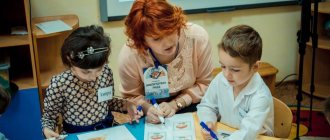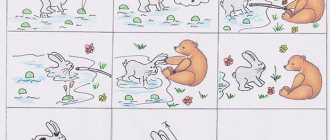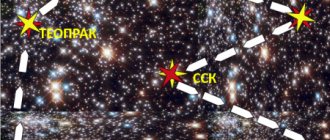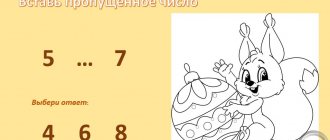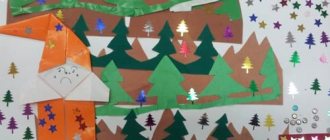MDOU Child Development Center - kindergarten No. 000, Cherepovets
Planetarium in kindergarten
Preface
In order to create conditions for children to develop ideas about the solar system and various cosmic phenomena, to get acquainted with the planets revolving around the Sun, constellations, comets, meteorites, solar and lunar eclipses, the teachers of our institution conceived and implemented the “Planetarium” project.
The premises for the project were quickly found - the spacious corridor on the first floor was perfect for the intended purpose. The design project competition revealed the winner - the teacher. To transform the corridor into a planetarium, paints, rollers, brushes and finishing materials were required. We purchased all the materials using the institution’s income from providing additional paid educational services right before our eyes. The outlines of our hometown, the region, with their magnificent rich nature appeared, helicopters and planes flew up over the treetops. The color of the sky became richer and there, in the heights, a balloon hovered, and a rocket quickly flew upward. The layers of the atmosphere became denser, and now we saw space. People work there too. Their aircraft and spaceships are varied in appearance. And then - meteorites and comets flash by, and the constellations of the zodiac circle twinkle in the starry sky. And, of course, the Sun, so bright and far from us.
To give the “dome of the starry sky” a complete look, the parents of our students assembled two “cosmic” curtains from shiny strands of crystals and beads. The mother of Sasha and Alena Vinogradov, Anna Viktorovna, came up with such a curtain. It turned out simply fabulous and mesmerizing. The teachers painted the walls with landscapes of their hometown. We hired a designer and made folding furniture for classes in the planetarium - benches for children, a table for demonstrating material.
The teachers developed special teaching materials for working in the planetarium, made a selection of books and demonstration material on the topic “Space,” and sewed costumes for organizing games and activities.
Our planetarium provides an opportunity to introduce children to the basics of astronomy, talk about the globe, its atmosphere, allows them to fly into the unknown world of Space through play activities, see all the planets of the solar system up close, broaden their horizons and increase the level of general development of children. The planetarium is also very convenient for introducing children to modes of transport, because it gives an idea of land, water, air and space modes of transport.
And in group No. 7, teachers created their own planetarium, which introduces children to the problem of environmental pollution and the deterioration of environmental conditions.
Journey to the Moon
Summary of the role-playing game
Goals:
ü To develop the ability to independently develop a simple plot that reveals events that can occur in space.
ü Provide the opportunity to apply their knowledge from various sources (books, encyclopedias, conversations, looking at pictures, films about space).
ü Demonstrate how to coordinate the plot before the game.
ü Give the opportunity to independently distribute roles, understand an imaginary situation and act in accordance with it.
ü Train in the ability to alternately perform 2-3 roles.
ü Consolidate the knowledge acquired about space (and, in particular, about the Moon).
ü Learn to use various construction sets, building materials, and substitute items.
ü Develop creative imagination.
ü
Game materials: k
space sky art, toy elements of spaceships, binoculars, space suit for an astronaut, alien costumes, building material.
Suggested preliminary work:
ü Excursion to the kindergarten planetarium.
ü Watching a film about space exploration (in particular, about the Moon) - can be given as homework.
ü Reading books about space.
ü Examination of illustrations and encyclopedias about space, planets, aliens
ü Summarizing conversation on the work done.
ü Conversation about the profession of astronaut.
ü Conversation “People’s work on spaceships.”
ü A conversation about how astronauts live in spaceships during flight, what they eat, etc.
ü Looking at illustrations of how a spaceship works.
ü Didactic games “What is needed to fly to the moon”, “On the water, in the air, on the ground”, “Who can name the most actions”.
ü Outdoor game “Airplanes”.
ü Fine art and manual labor:
— drawing airplanes, spaceships, starry skies, aliens, astronauts;
— modeling of airplanes, flying saucers, planets;
- cutting out stars along the contour to create game decorations, etc.
— joint production of astronaut and alien costumes with parents.
ü Accumulation of attributes for the game: binoculars, control wheels, elements of spaceships (antennas, remote controls, etc.).
ü Creation of a planetarium in a group.
Game roles:
astronauts, aliens, dispatcher on Earth.
Progress of the game:
ü The teacher invites 3-4 children to fly to the moon.
ü A game box with appropriate material is brought to the table.
ü Teacher:
“Who are these things for? What does an astronaut do during a flight? Where do the aliens meet us?
ü A spaceship is constructed from large building materials.
ü The teacher takes on the role of an astronaut - shows a sample of role-playing actions: launching a spacecraft, photographing space, using binoculars, a telescope.
ü Landing on the moon, meeting with aliens. The teacher helps build a role-playing dialogue:
- “Is it morning or night now?”
- “What’s your weather like: warm, cold?”
- “What are you doing on the moon?”
- “Are there many inhabitants on the Moon?”
- “What do you eat?” etc.
Next, the aliens can treat the astronauts to a magical drink, offer to play with them, take them on an excursion to the Moon, etc.
ü The teacher encourages and supports initiative in the formation of an imaginary situation
ü Boarding the spacecraft, returning to Earth.
End of game:
Children who have just been in space share their impressions with the rest of the children, answering their questions: “Did you like it or were you scared?”, “What interesting things did you encounter on the Moon?”, “If you fly next time, who would you be?” wanted to be an astronaut or an alien?”, “What qualities should an astronaut have?”
Game options:
ü Before starting the game, prepare the astronauts for the flight: get acquainted with the qualities of astronauts (strong, smart, hardworking, cheerful and friendly)
;
test of strength (run, practice on a balance beam, jump, perform gymnastic exercises, compete in throwing at a target)
;
testing knowledge on speech development (for example, questions are asked: “What planet do we live on?”, “Who was the first to fly into space?”, “Is the Moon a planet or not?”, etc.
); competition for the best craft made from plasticine, etc.
Features of the business, pros and cons
Initially, planetariums pursued educational and educational goals, but over time, entrepreneurs saw their commercial potential. In this case, it was the desire of citizens to spend their leisure time in an interesting and varied way that led to the emergence of mobile versions of such establishments. Planetarium programs are no longer limited to astronomy and demonstrations of constellations: their repertoire includes videos about nature, paleontology, history, and natural science. There are even feature films designed to be shown on a hemispherical screen.
Accordingly, the content of mobile planetariums has turned from boring lectures into a real show. Who will enjoy such entertainment:
- The main visitors to the planetarium will be school-age children. Most films are educational in nature, which corresponds to the interests of teenagers studying the world around them.
- Preschoolers may also be interested in the planetarium. But it is recommended not to allow children into the sessions, and children over 5 years old should be with their parents. Bright pictures and loud sounds can frighten them.
- Adults should not be excluded from the audience. Today, studios produce many serious films about the structure of living organisms and the Universe, black holes and dark matter. Everyone comes to these sessions.
Since the audience of mobile planetariums has no restrictions on age or social status, we can assume that such a business will become relevant in any city and in any society. Besides:
- Opening a mobile planetarium does not require such serious investments as creating another entertainment establishment - an anti-café, bowling alley or billiard room.
- There are many studios in Russia and abroad that offer a range of films for any audience - from preschoolers to retirees.
- Finding planetarium equipment is easy. Unlike stationary establishments, ordinary office equipment is used here, and the dome itself is inexpensive.
- A planetarium requires a minimum number of employees to operate. The entrepreneur can service it independently.
- Due to low overhead costs, high profitability is achieved, and the initial investment, even with an average load, pays off in less than six months.
Despite these advantages, you can often see advertisements on the Internet for the sale of mobile planetarium kits. This is explained by the disadvantages that novice entrepreneurs forgot to take into account:
- The planetarium has to compete with other entertainment options, including 3D cinemas, amusement rides and theatrical performances.
- Viewers quickly become bored with the repertoire, and new films have to be paid for. A license for a good program can cost up to two thousand euros.
- Due to information overload, the audience becomes passive and strives for new knowledge not nearly as actively as it did a couple of decades ago.
"Solar system"
| Target: | Give children an idea of the solar system; give an idea that the Sun and planets are spherical in shape; develop concentration and imagination; develop coordination of movements |
| Material: | A box with 8 different balls - planets, a large yellow ball - the Sun, orbital ropes, an “asteroid belt”, black fabric. |
| Age: | 5 – 6 years |
| Exercise 1 | 1. The teacher and the child bring the material. Take out and spread the fabric on the mat. 2. The teacher lays out the Sun and planets, conducting a three-step lesson: a. This is the Sun. The sun is a ball. · This is the planet Mercury. The planet is a ball. · This is the planet Venus. Planet - ball, etc. · This is the orbit - the constant path along which the planet revolves around the Sun. · This is a comet - a block of ice with solid particles and a cloud of gas that stretches behind like a tail. b. Show me…· Give me… · Put… c. What's this? 3. The child is asked to arrange the materials independently. |
| Exercise 2. | 1. The teacher and child bring the material to the mat. 2. Take out the first three planets: Mercury, Venus, Earth; 3. The teacher gives a three-step lesson on names. 4. Lay out the already known planets in order. Note: Other planet names are taught in the same way. |
| Exercise 3. | 1. The child brings the material to the mat; lays out the solar system. The teacher shows work with name cards. |
| Exercise 4. | 1. Same as in exercise 3 2. Cards with numbers are introduced - the serial numbers of the planets. Option : You only get planets, cards with names and numbers. Assignment: “Give the name and serial number to the planets.” |
| Exercise 5. | Drawing your solar system. |
| Exercise 6. | 1. Cards with texts - information about the planets, the asteroid belt, the Sun, comets, the Solar system.Reading and unfolding |
| Error control: | Test poster “Structure of the Solar System”. |
Advantages of offering a mobile planetarium for children's institutions
- There is no need to organize trips for children; the mobile planetarium itself will arrive where needed and at any time.
- A session with all organizational aspects takes exactly one lesson, so there is no need to disrupt the educational process.
- Sessions in the planetarium increase interest in development and learning, increase the degree of assimilation of educational materials, as they combine entertaining, educational and educational moments.
The mobile planetarium is absolutely safe, as it consists of fire-resistant material, it has no floor, so unobstructed exit is possible. Inside the planetarium, the ventilation system is constantly running, which means it can’t be stuffy there.
"Solar System 2"
| Target: | — give children an idea of the solar system; — give an idea that the Sun is a star and has a spherical shape; — give an idea that all planets are spherical; — introduce the names of the planets of the solar system; — give an idea of the movement of planets around the Sun. |
| Material: | A box with eight different balls - planets, a large yellow ball - the Sun, a wooden canvas with indentations for the planets and drawn orbits, a control card. |
| Show I: | 1. The teacher and the child bring the material. He takes out a typesetting cloth. 2. The teacher points to the typesetting canvas, lays out the balls and says: “This is the Solar System. In the center is the Sun. The sun is a star. Planets don’t revolve around us.” 3. The teacher lays out the models of the planets, gives them a name, and compares the models of the planets with the images on the control card. a. The teacher says: “We have laid out the solar system. Now try it yourself." |
| Exercises | 1. The teacher lays out a model of the Sun and a model of Mercury on a typesetting canvas. Conducts a three-step lesson. - This is the Sun. The sun is a star. - This is a planet. - This is an orbit - the path that a planet takes around the Sun. 2. The teacher and child bring the material, take out the first three planets: Mercury, Venus, Earth. A three-step lesson on names is given. In this way, the names of all the planets are learned. 3. Drawing your solar system. |
| Age | 4-7 years |
How much can you earn by opening a mobile planetarium?
During weekdays, approximately 8 trips will be made per month; 3 groups (15 people) will be served on each trip. On the weekend there will be about 5 sessions, but the hall will be only 20% occupied. The total number of people served per month will be: (8 x 3 x 15) + (8 x 5 x 15 x 20%) = 480 tickets sold.
Price of 1 ticket = 100 rubles.
Total monthly revenue: 480 x 100 = 48,000 rubles.
Net monthly profit: 48,000 – 30,000 = 18,000 rubles.
Annual profit: 18,000 x 12 = 216,000 rubles.
The payback period for the Mobile Planetarium project will be 1 year.
These indicators are calculated taking into account the very low workload of the project. In conditions of decent advertising and daily work, economic efficiency indicators will be much higher.
"Constellations"
| Target: | Give an idea of the constellations; develop attention and visual perception; replenish your vocabulary, stimulate interest in exploring the world around you. |
| Material: | 1 set: In the box: · Control cards with constellations and their names; · Cards with images of constellations; · Cards with names. Set 2: 2 boxes, one with black fabric, the other with cardboard stars (large and smaller); star map. |
| Age: | 5-8 years |
| Exercise 1 | With a set of vocabulary cards. |
| Exercise 2 | Material: combined sets 1 and 2. 1. Take out the material: control cards with constellations and their names; black fabric and a set of cardboard stars. 2. Control cards are placed at the top center of the mat; the fabric is laid out underneath them. On the right is a box with stars. 3. The child lays out the first constellation on the fabric with stars of different sizes, having first read its name. Then he removes it and puts the control card aside; reads and composes the second constellation, etc. |
| Exercise 3 | Material: Sets 1 and 2 – cards with images of constellations and a star map.Look at the constellations, find it on the map, read the name (complication: pick up a card with the name) |
| Exercise 4 | Material: star map; box with stars, fabric. Look at the constellations on the map; Place the constellations you like on the fabric. |
| Exercise 5 | Three-step lesson on constellation names.Game in pairs: 1 child shows a card with a picture of a constellation. The 2nd child names (or picks up a card with a word). |
| Exercise 6 | You can make your own material: · Draw the constellations and sign them; · Execute the application. Note: children can come up with various options themselves as they work. |
| Error Control | Visual – using control cards; according to the control card. |
Description of the project “Mobile Planetarium”
- An inflatable dome, which is made of durable material that does not transmit light. Inside the dome, a video image is demonstrated on the entire internal surface at 360 degrees. This is possible thanks to the internal coating of the dome, a projector and a special hemispherical mirror. This creates a kind of “presence effect”
- The structure is light and compact in design; it can be placed almost anywhere, both outdoors and indoors. The main thing is that the room has an area of at least 40 square meters. meters and a ceiling height of 3.5 meters, these could be gyms of kindergartens and schools, shopping centers.
- A sea of unforgettable experiences for children and possibly adults. Planetarium programs allow you to immerse yourself in the secrets of the world, explore the corners of our planet, improve your erudition and increase knowledge about the world around you. The unusual presentation of educational material makes the learning process exciting and accessible for children even in the provincial parts of our country.
Installing the planetarium structure takes a total of about 20 minutes, the dome is inflated using an air blower in 5 minutes, the rest of the time is spent on placing equipment and chairs. Only 1 person can manage the planetarium and make trips to different schools, camps and kindergartens. Thus, it can be called mobile.
"The Loose Encyclopedia on Space"
| Target: | Learn to work with reference books and write reports |
| Material: | Ticket with name; cards with images of objects and phenomena, texts to them (there is a serial number on the back of each card). |
| Age: | 6-7 years |
| Show: | 1. This material is called “Loose encyclopedia on space”. 2. The child selects any card (or a card by serial number), then selects a ticket with a name and a card with text. 3. Control is carried out by the number on the back side. Note : Using one of the cards or using the material read and fully worked out, you can make a report, a story, which is read out or told in a collective lesson. |
What equipment to choose for a mobile planetarium
Sessions can be attended by a variety of age groups, and there are many films to suit different interests and ages. The dome with a diameter of 5 meters can accommodate up to 15 people.
It is possible to purchase planetarium equipment individually or as a complete turnkey set. The list of required equipment includes:
- Dome
- Spherical mirror
- Projector Full hd 1920*1080
- Player with connecting cables
- Supercharger
- Acoustic system
- Projector stands and mirrors
- Connecting wires
- Movie
All this will cost approximately 155,000 rubles.
You will also need chairs or sofas (RUB 15,000), as well as equipment delivery (RUB 20,000). Total capital investments will amount to 190,000 rubles.

